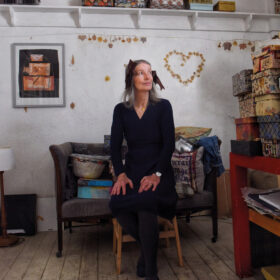
To this artist, a leaf is not just a leaf or an apple: to her, they are passionately specific, particular, and forever part of the time, day, and place with which she associates them, the emotions with which she invests them, they are entries in her diary. Christopher Andreae, 1993
Sylvia von Hartmann has lived in Scotland for decades, originally based in the Scottish Borders, she now lives and works in the heart of Edinburgh’s Old Town. She is an artist known for her works on paper in water-based media and wax crayon and also specialises in printmaking. Her imagery is highly personal, a psychological iconography which must remain obscured; her forms, motifs, script, flora and architecture are revealed in a folk tale with no beginning or end. Revealed as they float past on a liquid surface, or retreat, detail rubbed back like the surface of an ancient sampler. Sylvia von Hartmann was born in Hamburg, Germany; she studied at the Werkkunstschule, before attending Edinburgh College of Art (1963–66).
To this artist, a leaf is not just a leaf or an apple: to her, they are passionately specific, particular, and forever part of the time, day, and place with which she associates them, the emotions with which she invests them, they are entries in her diary. Some diaries have been written in code for intimacy’s sake. Sylvia von Hartmann’s method of composing her pictures is itself a kind of code to preserve secrets, to protect, to only partly reveal. The way she makes her pictures is not some coolly contrived technique. It is integral to the character of her work. She uses gouache – opaque watercolour – and over it she works with pigmented wax. This wax, of German manufacture, is today made especially for her. She then draws through the wax surfaces and veilings with a razor blade and an old steel gramophone. She is therefore on the one hand covering over, and on the other, disclosing, taking away surface, and working down from one image to another, as she chooses. In this way, a final picture can contain completely invisible or only partly visible earlier states, all of which, she feels, are necessary in the passage of the picture’s making, but known only to her memory of them. Extract from Leaves in a Metaphoric Garden by Christopher Andreae, 1993
Public collections include: Scottish Arts Council; National Galleries of Scotland, Edinburgh; City Art Centre, Edinburgh; Aberdeen Art Gallery & Museums.